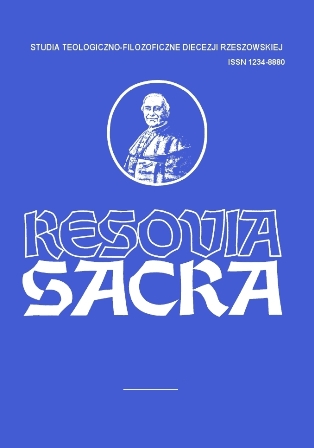CZUWANIA SOBOROWE FORMĄ DUCHOWEJ OBECNOŚCI KOŚCIOŁA POLSKIEGO
NA SOBORZE WATYKAŃSKIM II
THE CONCILIARY VIGILS AS THE FORM OF THE SPIRITUAL PRESENCE OF THE POLISH CHURCH AT THE SECOND VATICAN COUNCIL
Author(s): Arkadiusz SmagaczSubject(s): Christian Theology and Religion, History of Church(es), Theology and Religion
Published by: Instytut Teologiczno-Pastoralny im. św. Józefa Sebastiana Pelczara w Rzeszowie
Keywords: Second Vatican Council; Church in Poland; the conciliary vigils; John XXIII; kard. Stefan Wyszyński
Summary/Abstract: Convened 50 years ago, the Second Vatican Council was a groundbreaking event in the history of the Common Church. Under difficult conditions of the communist regime, the Church in Poland contributed to the Council work in numerous areas. The decided majority of bishops, despite the problems with receiving passports, participated in the conciliary meetings directly. However, a wise shepherd of the Polish Church, which can definitely be said about Primate Stefan Wyszyński, wished that the matter of the Council became present in every Polish parish and family. By his inspiration a four-year pastoral program was created, commonly referred to as ‘the conciliary vigils’ whose aim was to pray and make offerings in the intention of the Second Vatican Council. The conciliary vigils became a unique work in the entire Common Church. Thanks to them the members of the Polish Church, despite the existence of the iron curtain, were able to take spiritual part in this significant event. In the first part of this article the author attempts to find the answer to the following question: what was the foundation of the conciliary vigils? The answer was contained in three theses: the influence of the attitude represented by Saint John XXIII, who was so dearly connected with Poland and Cardinal Wyszyński and his calling for prayer in the intention of the Council; ecclesiological sensitivity of the Primate of Poland, which expressed itself in the perception of the Church as the mystical Corpus Christi and his unique gift to translate into practice sublime theological assumptions. In the second part the author focuses on the presentation of the course of particular stages of conciliary vigils which also constituted the part of the Great Novena of the Polish Nation. Those were consequent initiatives: in 1962 – The conciliary vigil with Virgin Mary of Jasna Góra, in 1963 – the Conciliary deed of goodness; in 1964 – Victory over oneself for the Council and finally, in 1965 – giving oneself to the maternal enslavement of Virgin Mary, the Mother of Church for the freedom of the Church.
Journal: Resovia Sacra. Studia Teologiczno-Filozoficzne Diecezji Rzeszowskiej
- Issue Year: 2014
- Issue No: 21
- Page Range: 387-411
- Page Count: 25
- Language: Polish

